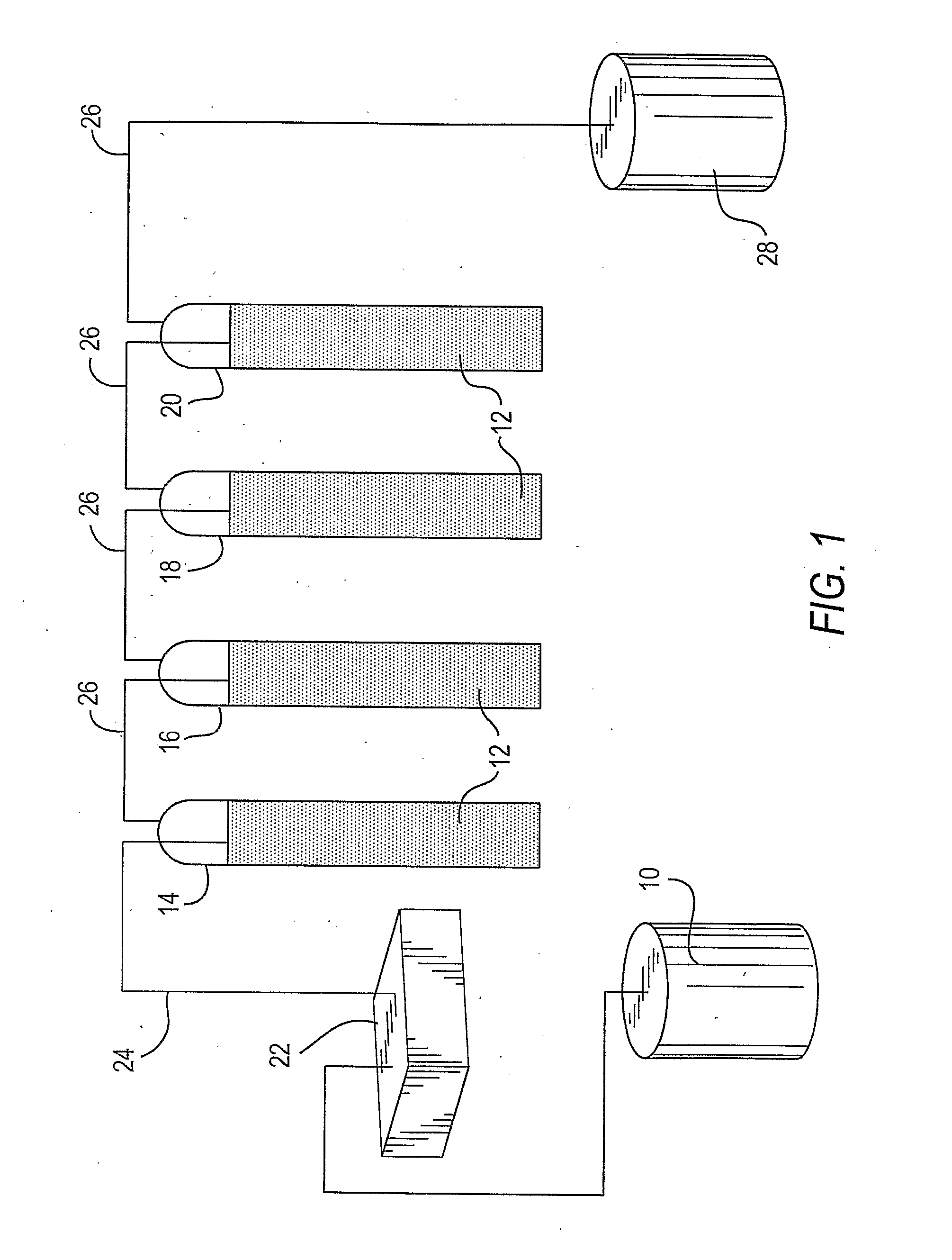Reactive Extraction of Sulfur Compounds from Hydrocarbon Streams
a sulfur compound and hydrocarbon stream technology, applied in the field of liquid liquid liquid, can solve the problems of corroding processing equipment and engine parts, other deleterious effects, and difficulty in achieving the low concentration of hsub>2/sub>s
- Summary
- Abstract
- Description
- Claims
- Application Information
AI Technical Summary
Benefits of technology
Problems solved by technology
Method used
Image
Examples
example 1
[0056] A stock solution of hydrocarbon containing butanes, pentanes and hexanes was prepared containing 82 mg / liter ethyl mercaptan, 84 mg / liter dimethyl sulfide, and 105 mg / liter dimethyl disulfide. Four extraction solutions were prepared as follows, where all concentrations are set forth in weight percent: Sodium Hypochlorite (5.25%); Trichloroisocyanurate (1.70%) and Sodium Hydroxide (2.00%); Calcium Hypochlorite (1.50%), and Sodium Hydroxide (1.59%).
[0057] A 10-ml sample of the stock solution was extracted separately by each of the reagent solutions for five minutes with intermittent shaking. The layers were allowed to settle, then an aliquot was withdrawn and analyzed by GC-SCD. The results appear in Table I and indicate the efficiency of each reagent mixture.
[0058] Sodium Hypochlorite (5.25%) was effective to remove more than 94% of ethyl mercaptan (ETSH) and dimethyl sulfide (DMS), and removed more than 78% of dimethyl disulfide (DMDS). Less than one mg / liter of methyl ethy...
example 2
[0068] A stock solution of 21 mg / liter ethyl mercaptan, 40 mg / liter dimethyl sulfide, and 71 mg / liter dimethyl disulfide in mixed hexanes was prepared. In this experiment, 10 ml of the stock solution was shaken with an aqueous extraction solution of 10 ml 5.25% NaOCl for five minutes in a 20 ml vial. The first sample was the stock solution. The second sample contained ferrous sulfate added at 500 mg / liter. The third sample contained nickelous sulfate at 500 mg / liter. The fourth sample contained 250 mg / liter ferrous sulfate and 250 mg / liter nickelous sulfate. The fifth sample contained only the NaOCl at 5.25%. After shaking the samples for five minutes, the samples were allowed to separate and the top layer was sampled, added to the injection vial, and analyzed by GC-SCD with a detection limit of 0.5 mg / liter sulfur. All concentrations are in mg / liter as sulfur.
[0069] As can be seen from an examination of Table III, when used separately, the ferrous and nickelous catalysts are both ...
example 3
[0070] Referring to FIG. 1, a solution of light hydrocarbons containing butanes, pentanes and hexanes in feed tank 10 was treated with an extraction agent 12 using sparging chambers 14, 16, 18, and 20 as the contactor apparatus.
[0071] At the bottom of each of the sparging chambers, glass fritts, not shown, were provided which allowed the hydrocarbon solution to be pumped by pump 22 into the bottom of each of the chambers via line 24 and then into the reagent 12 to slowly disperse upwardly through extraction agent 12, and collecting at the top of each of the chambers where it was discharged into a collection line 26 and then collected in product tank 28.
[0072] Each of the chambers 14, 16, 18 and 20 were filled with extraction agent 12, which consisted of 250 ml of 5.25 weight % sodium hypochlorite, which contained 500 mg / liter of nickelous sulfate. The nickelous sulfate is present as a mostly dark blue solid, giving a slurry which is ebbulated by the action of the hydrocarbon solut...
PUM
 Login to View More
Login to View More Abstract
Description
Claims
Application Information
 Login to View More
Login to View More - R&D
- Intellectual Property
- Life Sciences
- Materials
- Tech Scout
- Unparalleled Data Quality
- Higher Quality Content
- 60% Fewer Hallucinations
Browse by: Latest US Patents, China's latest patents, Technical Efficacy Thesaurus, Application Domain, Technology Topic, Popular Technical Reports.
© 2025 PatSnap. All rights reserved.Legal|Privacy policy|Modern Slavery Act Transparency Statement|Sitemap|About US| Contact US: help@patsnap.com



